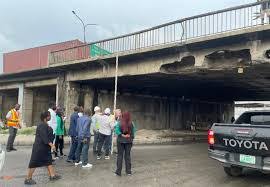The Federal Government is currently considering two major options for the rehabilitation of the aging Carter Bridge in Lagos: a complete replacement of the bridge with a modern cable-stayed structure at a projected cost of ₦320 billion, or embarking on extensive repairs that could cost as much as ₦380 billion.
Minister of Works, Dave Umahi, disclosed this during an inspection visit to the bridge site in Lagos, where he was accompanied by a team of engineers from the ministry. The Carter Bridge, which links Lagos Island to the mainland, is one of the oldest bridges in Nigeria’s commercial hub and has shown worrying signs of structural deterioration.
Umahi, who expressed deep concern over the state of the bridge, described it as “dangerous” and in need of urgent attention. He noted that while surface-level repairs have progressed significantly, investigations have revealed that the underwater structure has suffered severe corrosion, with detached caps and damaged piles weakening the bridge’s integrity over time.
“Julius Berger has completed about 80 per cent of the above-water repairs,” Umahi explained. “But our investigations uncovered serious underwater issues. Corroded piles and detached caps pose long-term risks similar to what led us to restrict heavy truck movement on the Third Mainland Bridge.”
The minister confirmed that only two firms have submitted proposals for the ongoing bridge rehabilitation projects in Lagos: BuildWell for the Third Mainland Bridge, and Julius Berger Nigeria Plc for the Carter Bridge. The Ministry of Works is currently reviewing these proposals and will soon forward its recommendation to President Bola Tinubu for final approval.
Umahi stated that a new bridge could last over 100 years, making it a more durable and cost-effective solution in the long run. He added that international investors had shown interest in helping Nigeria finance such a critical infrastructure project.
“We are seriously considering replacing the Carter Bridge with a cable-stayed bridge. It’s a better engineering alternative and will save money over time,” he said.
He also commended Julius Berger Nigeria Plc, praising the company’s new management for their cooperation and flexibility in cost negotiations. “They initially quoted ₦27 billion for some works, but after discussions, we agreed on ₦17 billion,” Umahi revealed.
Also speaking at the inspection, Thomas Christl, the Regional Technical Manager, Region West of Julius Berger, acknowledged the extent of the damage and confirmed that the company had been working on above-water components of the Carter Bridge since 2024. These include handrails and pile caps. However, he clarified that the current contract does not cover the full structural restoration, particularly underwater repairs.
Christl echoed the minister’s concerns, stating, “After our investigations, we advised that a full replacement might be a better and more sustainable option. A new bridge will serve Nigeria for the next 100 years, and several international investors have expressed willingness to finance it.”
Past assessments of the bridge in 2012 and 2019 also flagged similar structural deficiencies, which have now worsened due to prolonged exposure and limited rehabilitation. Experts say these assessments support the argument for a complete replacement rather than pouring more resources into increasingly expensive repairs.
The Carter Bridge, first constructed in the early 1900s and later rebuilt in the 1970s, is one of three major bridges connecting Lagos Island to the mainland—the others being the Eko Bridge and the Third Mainland Bridge. All three bridges have been under scrutiny in recent years due to aging infrastructure and rising traffic pressure.
The government has said it will prioritise whichever option offers the best long-term value in terms of safety, durability, and cost. For now, stakeholders and residents await a final decision that could significantly reshape Lagos’ infrastructure landscape.
